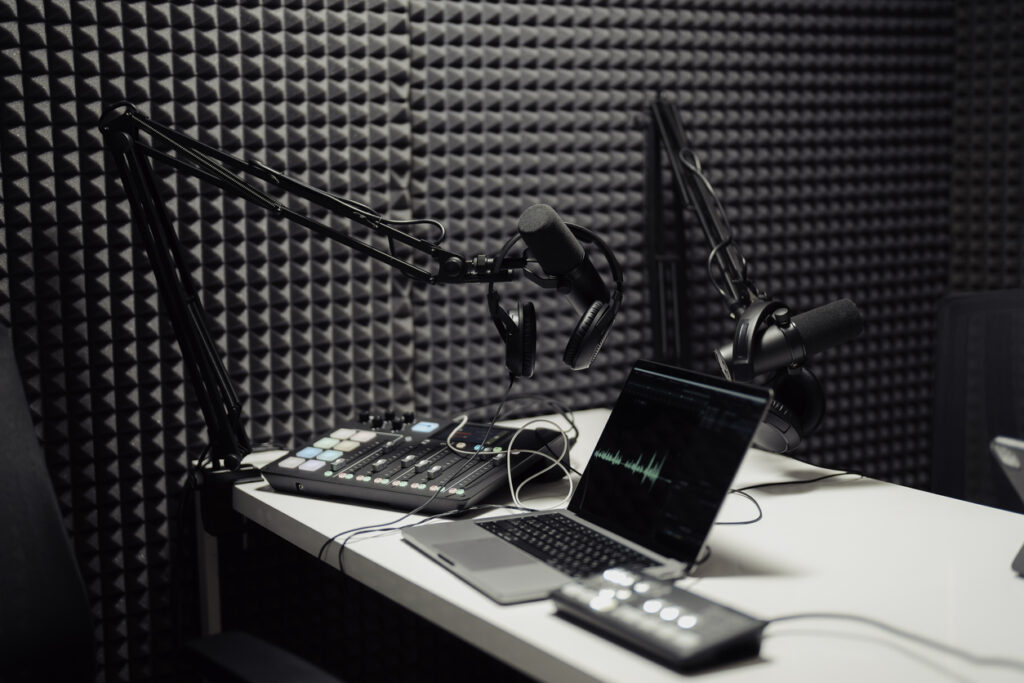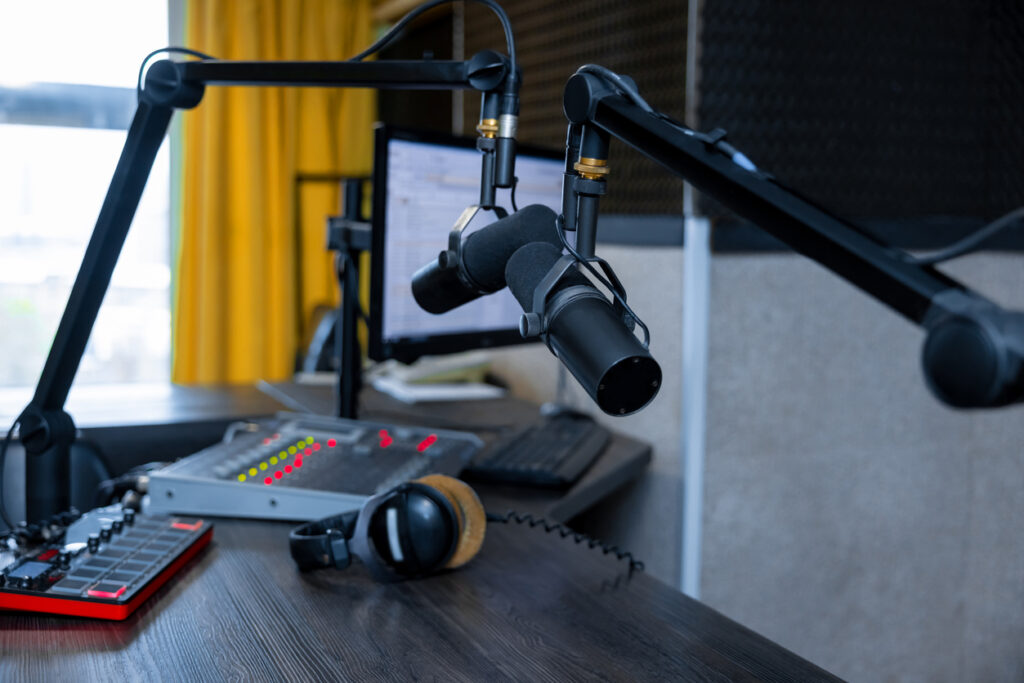Did you know that over 50% of podcast listeners say audio quality is the first reason they’ll tune out, before content or guests? You’ve built a product, found your market fit, and now it’s time to build trust at scale. But gear decisions can stall even the sharpest teams. Podcasting for startup growth isn’t just about having great ideas; it’s about delivering them clearly and consistently.
Based on your stage, whether you’re validating your format or scaling a full-blown content engine, this tiered setup helps your team launch fast, sound pro, and avoid overspending on the wrong tools.
1. Lean MVP Setup – Just Ship It (Under $150)

Ideal for: Testing your podcast idea or content approach
Starting a podcast for your startup doesn’t have to break the bank. This basic setup gives you everything you need to start recording quality episodes without spending too much time or money.
- Microphone: The Samson Q2U($69) or the Fifine USB microphone ($45) both give you clear sound at a great price. The Q2U works with both USB and XLR connections, so you can upgrade other parts of your setup later without buying a new mic.
- Headphones: Audio-Technica ATH-M20x ($49) lets you hear exactly what you’re recording without any sound leakage. If you already have closed-back headphones, those will work fine too, just don’t use earbuds or open-back styles that let sound escape.
- Recording Software: Audacity (Windows) and GarageBand (Mac) are completely free but still powerful enough to make professional-sounding podcasts. They’re easy to learn, so you can focus on your content instead of fighting with complicated software.
- Hosting: Spotify for Podcasters (formerly Anchor) costs nothing to start and puts your show on all the main podcast apps automatically. Buzzsprout’s free plan is also good for beginners, though you can only upload a limited amount each month.
✅ Goal: Get started quickly. Don’t worry too much about perfect sound, focus on making valuable content. Your first listeners care more about your unique insights than studio-perfect audio.
2. Growth-Stage Stack – Ready for Guests & Scale (Under $500)

Ideal for: Startups making podcasting a key part of their marketing plan
Once you’ve proven your podcast concept and committed to regular episodes, these upgrades will make your show sound much better and save you time. There are important when podcasting becomes a core part of your content strategy.
- Better Mic: The Shure MV7 ($249) brings radio-quality sound with both USB and XLR connections and built-in sound processing. If that’s too pricey, the Rode NT-USB ($169) sounds great too. Both work well with different voice types and cut down on room noise.
- Audio Interface: The Focusrite Scarlett Solo ($119) lets you use professional XLR microphones, giving you cleaner sound and better volume control than USB alone. This one purchase will keep your setup current for years.
- Helpful Extras: Add a pop filter ($15) to stop those harsh “p” and “b” sounds, a boom arm ($40) for easy mic positioning, and a shock mount ($30) to prevent desk vibrations from ruining your recording. These small additions make a big difference in sound quality.
- Editing Tools: Descript ($12/month) changes how you edit by turning your audio into text. Edit your podcast by simply editing the words—perfect for busy marketing leaders who need to turn podcast clips into social media posts and blog articles.
- Hosting: Libsyn ($20/month) or Transistor ($19/month) give you better listener stats, growth tools, and ways to insert ads later. Their dashboards help you track how your podcast fits into your overall startup marketing plan.
✅ Best for teams doing regular interviews, creating content across multiple platforms, and tracking results carefully. This setup hits the sweet spot between quality and cost for most growing startups.
3. Studio-Grade Setup – For Founders Going All-In ($1000+)
Ideal for: Marketing leaders making video podcasts, YouTube clips, or building a serious content operation
When your podcast becomes central to your brand building or brings in good leads, these investments create a polished, multi-format content machine that stands up to industry leaders.
- Pro Mic: The Shure SM7 B ($399) with a Cloudlifter CL-1 ($149) is what the top podcasters use, including Joe Rogan and NPR hosts. It gives a rich, warm voice quality that immediately sounds professional to listeners.
- Camera: The Sony ZV-1 ($749) records sharp 4K video with excellent auto-focus made for content creators. If that’s too expensive, the Logitech Brio ($199) gives surprisingly good 4K quality for desk setups.
- Lighting: Basic softbox lights ($80) or a ring light ($60) remove unflattering shadows and make your video look professional. Good lighting makes even smartphone footage look intentional and on-brand.
- Sound Treatment: Acoustic foam panels ($60) or a portable recording booth ($99) greatly reduce echo and background noise. This becomes really important when using content across different platforms or recording in noisy offices.
- Recording Platform: Riverside.fm ($15/month) or SquadCast ($20/month) record separate audio and video files for each person, ensuring clean quality even with internet problems. They also make managing guests much easier.
✅ Think of this as an investment in building authority and long-term content value. At this level, your podcast becomes a powerful tool for generating leads and building your brand reputation.
What Not to Waste Money On
Even well-funded startups need to spend wisely. Avoid these common equipment mistakes:
- Don’t buy expensive gear before settling on your show format. Many startups purchase premium equipment only to change their podcast concept later, requiring different gear altogether.
- Skip microphones without cardioid pickup patterns (ones that pick up sound from all directions). They record too much background noise and room echo, making editing much harder for your team.
- Avoid complicated editing programs at first. Tools like Adobe Audition or Pro Tools are powerful but have steep learning curves when speed matters more than perfect editing in your growth phase.
- Don’t chase trendy new gear with flashy marketing. The equipment recommended above has proven reliable for thousands of professional podcasters.
- Pass on expensive studio packages aimed at music producers. Podcasting has different needs, and many of those fancy features will go unused.
Remember that consistency beats perfection every time. A weekly podcast with good audio will perform better than a monthly show with perfect audio in your startup marketing strategy.
Quick-Start Checklist
No matter which tier you choose, follow these steps to get up and running fast:
- Set up a quiet recording space – even a closet with hanging clothes works better than an echo-filled conference room
- Test your gear thoroughly before scheduling guests
- Create a simple template for intros and outros to speed up editing
- Record in separate tracks whenever possible (your voice and guest voices separately)
- Always wear headphones while recording to catch problems early
As your podcast grows, you can gradually upgrade specific parts of your setup without replacing everything at once. Many successful startup podcasts begin with the Lean MVP setup and add pieces from higher tiers as they prove ROI.
The beauty of the tiered approach is that it gives you a clear upgrade path without overwhelming you with options. Start where your budget and commitment level make sense today, knowing exactly what to add next as your podcast becomes a more central part of your marketing strategy.
Get Started
Your podcast doesn’t need a $10K studio to build trust and traction, it needs the right setup for where your startup is today. By investing smartly and scaling intentionally, you’ll turn podcasting into a key pillar of your startup marketing strategy, not a money pit. The path to authority and audience growth is here, mic up and make it count.

